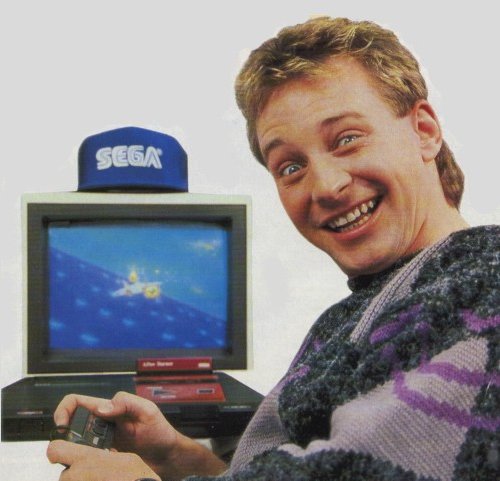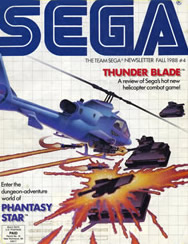Throughout the life span of the Genesis, few people saw it from so many angles as John Sauer. Starting at the company before the console was even launched, he was there right through its  rapid ascent and through the glory days of the Sega Scream and “Welcome to the Next Level.” As managing editor of Sega Visions magazine, Sauer had a unique perspective on the plethora of game titles that went through the company on a daily basis.
rapid ascent and through the glory days of the Sega Scream and “Welcome to the Next Level.” As managing editor of Sega Visions magazine, Sauer had a unique perspective on the plethora of game titles that went through the company on a daily basis.
Beginning at Sega as a writer for game packaging and Sega’s catalogue, he eventually moved up to working on getting the company’s massive amounts of Japanese first party titles ready for release in America. In this capacity he oversaw the localization of such 8-bit classics as the Wonder Boy games, Afterburner, Shinobi, and the mighty Phantasy Star. Soon after, Sauer joined the advertising department and took the reigns of the Sega Challenge newsletter. He then left the company but rejoined a few years later and joined the Sega Visions magazine team, where he remained until Sega cancelled the publication in 1996.
We were recently able to chat with Mr. Sauer about his time at Sega.
Sega-16: How did you get your start at Sega?
John Sauer: I was working at Tonka Toys as a copywriter. Tonka put a SMS in the lunchroom and I was the only one who could play it. That made me a natural and they put me on the U.S. marketing team, first as a copywriter and eventually as a marketing manager.
Sega-16: Sega of America was quite small when the Genesis launched. What was the atmosphere like there at the time?
John Sauer: Sega was relatively small but was growing and everyone saw the Genesis as the next big thing. The current Nintendo system could not compare with the graphics or gameplay…they truly were arcade quality for the time. It was a time of mixed emotion as well. Sega wanted to branch out on their own without Tonka support and Tonka was in the midst of being bought by Kenner Parker, so there was a lot of motion going on. It was very exciting and we were all pretty pumped. We knew we were ushering in a new generation of gaming.
Sega-16: You were also involved in advertising at Sega, to some extent. What did you think of Michael Katz’s strategies to promote the Genesis?
John Sauer: Personally, I thought they were great. Tonka classic toy style advertising and marketing gave the Master System enough support to be a launch platform for the Genesis and Michael wanted to break into a new radical direction and really get in your face. Some felt that it would not be successful but as history shows, he was on the money.
Sega-16: Nintendo was absolutely dominant in 1989. Did it ever seem to you like the Genesis wouldn’t succeed?
John Sauer: Never. I knew it would kick ass. Nintendo had the popular vote but the Genesis was so much better of a system and when the 3rd party developers got on board, it cemented the Genesis future.
Sega-16: Tom Kalinske was quite adamant about replacing Altered Beast as the Genesis pack-in title. Do you think he was right? Altered Beast doesn’t seem like much now, but it was quite impressive in 1989.
John Sauer: Yes. Sonic helped make the Genesis a household name and I believe that is was the single most effective marketing decision Sega has ever made.
 Sega-16: You were heavily involved in the localization of the original Phantasy Star on the Master System. Were you involved with bringing its first sequel to the Genesis? What did you think of it?
Sega-16: You were heavily involved in the localization of the original Phantasy Star on the Master System. Were you involved with bringing its first sequel to the Genesis? What did you think of it?
John Sauer: I absolutely loved the first Phantasy Star and had no involvement in most of the subsequent games (with the exception of Phantasy Star IV, where Rick Raymo and I snooped with the development team and did a lot of play testing as we wrote the hint book). I thought the sequel was not up to par with the original. None of the Phantasy Star games have every really captured that original magic.
Sega-16: You were editor of and appeared quite a bit in the old Sega Challenge Newsletter that featured the Master System. How did the transition to Sega Visions come about?
John Sauer: Sega Visions was born when GamePro Publishing took over the contract to produce the magazine. With its sharp focus on video gaming and a lot more experience to draw on, GamePro Publishing (IDG Publishing) worked with Sega to give the publication a complete makeover and make it a much more effective tool to help sell games.
Sega-16: What exactly were your duties as managing editor of Sega Visions?
John Sauer: I was Editorial Director, and was the main interface with Sega to make sure the publication was produced on schedule in coordination with Sega marketing and GamePro production. The Editors in Chief were first Nick Lavroff and then Kurt Busch, both great guys who were fun to work with.
Sega-16: Bill Kunkel has said that Sega Visions was essentially a marketing tool, much like Nintendo Power is. As managing editor, did Sega ever obligate you to only publish positive things about its games?
John Sauer: It was very much a marketing tool designed to help people form a tighter relationship with Sega. We worked hard to discuss games fairly and would deliver some [not too much, because we did have to walk the line between selling games, third party developers and free speech advocates] criticism of games that were not up to par. Third party games took more heat but we never took the tactic to blast a bad game like the “free market” publications could.
Sega-16: Do you think the magazine could have ever competed on the level of Nintendo Power?
John Sauer: Absolutely it did, in the world of Sega. Sega never had the mass market drive for Sega Visions that Nintendo still has for Nintendo Power. It was a great publication and when Sega pulled the plug on Visions, they lost their strongest connection with their game playing audience.
 Sega-16: Why exactly did Sega end publication of Sega Visions? Many gamers think it had to do with the company’s transition from the Genesis to the Saturn, but the magazine had successfully covered the Master System and Game Gear as well as the Genesis. What happened really?
Sega-16: Why exactly did Sega end publication of Sega Visions? Many gamers think it had to do with the company’s transition from the Genesis to the Saturn, but the magazine had successfully covered the Master System and Game Gear as well as the Genesis. What happened really?
John Sauer: Sega wanted to launch Saturn in a huge way and needed money to fund Lollapalooza, so they raided the Sega Visions budget. They offered GamePro Publishing the opportunity to publish Sega Visions as it was for advertising revenue only but it would have shifted money away from GamePro advertising, so GamePro declined. Sega decided that did not want to publish Visions anymore and canceled the publication. Saturn flopped and the game was pretty much over then. I still believe it was a very short-sighted move that contributed strongly to the end of Sega as a game system company. I have to admit I get a kick playing Sonic on a GameCube!
Our thanks to Mr. Sauer for taking the time for this interview.
Picture of John Sauer at Sega used with permission from Sega8bit.com.

Recent Comments